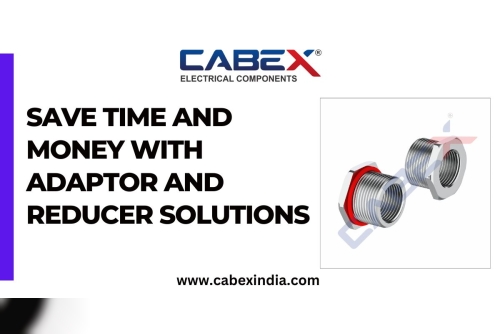Introduction:
Cable glands are crucial components in any industrial electrical application, providing a secure and weatherproof connection between cables and enclosures. However, in some situations, the perfect fit isn't readily available. This is where Adaptors And Reducers come into play, acting as essential intermediaries to ensure seamless and reliable cable connections. In this blog post, we'll delve into the world of adaptors and reducers, exploring their functionalities, applications, considerations, and frequently asked questions.
Understanding Adaptors and ReducersAdaptors: These fittings bridge the gap between two components with incompatible thread sizes. They come in various configurations, such as:
Male to Female: Connects a male threaded cable gland to a female threaded enclosure or vice versa. Female to Female: Creates a connection between two female threaded components. Male to Male: Allows the connection of two male threaded components (less common).Reducers: Reducers facilitate a connection between a cable with a larger diameter and an enclosure with a smaller thread size. They offer a smooth transition, maintaining a secure and reliable connection.
Here's a table summarizing the key differences:
Feature
Adaptor
Reducer
Functionality
Bridges incompatible thread sizes.
Reduces cable diameter to fit a smaller enclosure thread.
Configuration
Male to Female, Female to Female, Male to Male (less common).
Typically Male to Female.
Applications of Adaptors and Reducers in Industrial Settings:
The versatility of adaptors and reducers extends across numerous industrial applications:
Power and Distribution: Adapters and reducers play a vital role in connecting cables to transformers, switchboards, and other electrical distribution equipment with varying thread sizes. Process Control and Automation: These fittings are essential in control panels, instrumentation enclosures, and sensor connections where cables might have different diameters or thread types. Oil & Gas: Adapters and reducers ensure secure connections in hazardous environments like refineries and drilling platforms, where robust and reliable connections are paramount. Marine Applications: They play a critical role in shipbuilding and offshore installations, ensuring weatherproof and secure cable connections despite harsh conditions. Renewable Energy: Adapters and reducers facilitate connections in wind farms, solar power installations, and other renewable energy projects with varying equipment and cable requirements. Key Considerations when Selecting Adaptors and Reducers: Material: Choose materials like brass, nickel-plated brass, or stainless steel for durability and corrosion resistance in different environments. Thread Type: Ensure compatibility between the adaptor/reducer thread type and the cable and enclosure threads (e.g., NPT, BSP, Metric). Ingress Protection (IP) Rating: Select an adaptor/reducer with an IP rating suitable for the application's environmental conditions (e.g., dust, water exposure). Flame Retardance: For applications with fire safety concerns, consider flame retardant materials for added safety. Temperature Rating: Ensure the adaptor/reducer can withstand the operating temperature range of the application. Size and Weight: Select an adaptor/reducer appropriate for the cable size and weight to avoid excessive strain.Safety Tip: Always rely on reputable manufacturers like CabexIndia for high-quality, certified adaptors and reducers to ensure optimal performance and safety in your industrial applications.
FAQs Regarding Adaptors and Reducers:1. Can I use an adaptor/reducer to change the cable diameter permanently?
No, adaptors and reducers should not be used for permanent diameter changes. They are intended for creating temporary connections where cable and enclosure thread sizes are incompatible.
2. Are there any limitations to using adaptors/reducers?
While they offer valuable flexibility, excessive use of adaptors and reducers can introduce additional connection points, potentially increasing the risk of failure. It's always best to strive for direct connections whenever possible.
3. What happens if I use the wrong size adaptor/reducer?
Using an incompatible size can lead to a loose connection, which can cause arcing, overheating, and ultimately equipment failure. Always double-check the thread sizes and cable diameters before selecting an adaptor/reducer.
4. Do I need any special tools to install adaptors/reducers?
Typically, you can install adaptors and reducers using standard wrenches or spanners. However, always refer to the manufacturer's instructions for specific installation guidelines.
5. How do I ensure the quality of adaptors/reducers?
Look for adaptors and reducers that comply with relevant industry standards (e.g., IEC, UL) and are manufactured by reputable companies like CabexIndia, which prioritize quality and safety.
ConclusionAdaptors and reducers are essential tools for ensuring secure and reliable cable connections in industrial applications












